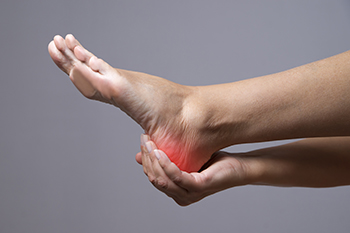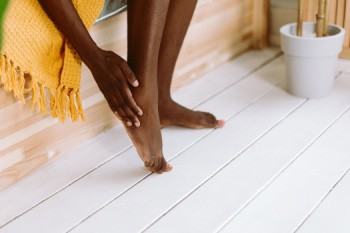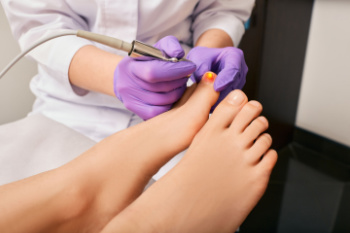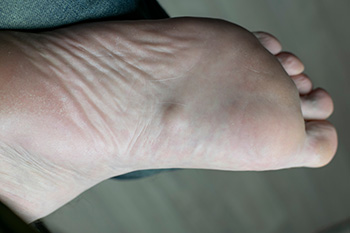Items filtered by date: September 2024
Why Live with Pain and Numbness in Your Feet?
What Are Heel Spurs?

Heel spurs are bony growths that form on the underside of the heel bone, often resulting from long-term strain on the foot’s ligaments and tendons. They can be quite painful, typically resulting in a sharp, stabbing sensation in the heel, especially with the first steps in the morning or after prolonged periods of rest. Symptoms also include tenderness and swelling around the heel area. Treatment options for heel spurs include wearing supportive shoes with cushioned insoles, performing stretching exercises to alleviate tension in the foot, and using orthotic devices to correct alignment issues. In some cases, pain relief or anti-inflammatory medications may help manage discomfort. If you think you have heel spurs, it is suggested you make an appointment with a podiatrist who can provide a personalized treatment plan and address underlying issues.
Heel spurs can be incredibly painful and sometimes may make you unable to participate in physical activities. To get medical care for your heel spurs, contact Edward Sharrer, DPM from Premier Foot and Ankle Clinic. Our podiatrist will do everything possible to treat your condition.
Heels Spurs
Heel spurs are formed by calcium deposits on the back of the foot where the heel is. This can also be caused by small fragments of bone breaking off one section of the foot, attaching onto the back of the foot. Heel spurs can also be bone growth on the back of the foot and may grow in the direction of the arch of the foot.
Older individuals usually suffer from heel spurs and pain sometimes intensifies with age. One of the main condition's spurs are related to is plantar fasciitis.
Pain
The pain associated with spurs is often because of weight placed on the feet. When someone is walking, their entire weight is concentrated on the feet. Bone spurs then have the tendency to affect other bones and tissues around the foot. As the pain continues, the feet will become tender and sensitive over time.
Treatments
There are many ways to treat heel spurs. If one is suffering from heel spurs in conjunction with pain, there are several methods for healing. Medication, surgery, and herbal care are some options.
If you have any questions feel free to contact our office located in North Little Rock, AZ . We offer the latest in diagnostic and treatment technology to meet your needs.
Managing Heel Pain

Unfortunately heel pain happens to many people. It is often caused by inflammation or injury to the tissues in the heel. The most frequent cause is plantar fasciitis, which occurs when the band of tissue connecting the heel to the toes becomes irritated. Early symptoms include sharp pain in the heel, especially with the first steps in the morning or after prolonged periods of sitting. Risks include obesity, excessive physical activity, and wearing unsupportive shoes. Complications from untreated heel pain include chronic discomfort and altered gait, which may strain other joints and muscles. Those most at risk are athletes, individuals with flat feet or high arches, and people who stand for long periods of time. Diagnosis is typically made through a physical exam and, if necessary, imaging tests like X-rays or MRI scans to assess the extent of damage. For persistent heel pain, it is suggested you schedule an appointment with a podiatrist who can provide an effective treatment plan.
Many people suffer from bouts of heel pain. For more information, contact Edward Sharrer, DPM of Premier Foot and Ankle Clinic. Our podiatrist can provide the care you need to keep you pain-free and on your feet.
Causes of Heel Pain
Heel pain is often associated with plantar fasciitis. The plantar fascia is a band of tissues that extends along the bottom of the foot. A rip or tear in this ligament can cause inflammation of the tissue.
Achilles tendonitis is another cause of heel pain. Inflammation of the Achilles tendon will cause pain from fractures and muscle tearing. Lack of flexibility is also another symptom.
Heel spurs are another cause of pain. When the tissues of the plantar fascia undergo a great deal of stress, it can lead to ligament separation from the heel bone, causing heel spurs.
Why Might Heel Pain Occur?
- Wearing ill-fitting shoes
- Wearing non-supportive shoes
- Weight change
- Excessive running
Treatments
Heel pain should be treated as soon as possible for immediate results. Keeping your feet in a stress-free environment will help. If you suffer from Achilles tendonitis or plantar fasciitis, applying ice will reduce the swelling. Stretching before an exercise like running will help the muscles. Using all these tips will help make heel pain a condition of the past.
If you have any questions please contact our office located in North Little Rock, AZ . We offer the newest diagnostic and treatment technologies for all your foot and ankle needs.
Facts About Laser Surgery for Toenail Fungus

Laser surgery for fungal toenails is an advanced treatment option designed to combat persistent fungal infections. This procedure uses targeted laser energy to penetrate the nail and destroy the fungus without harming the surrounding tissue. One notable benefit is its precision. The laser targets only the infected areas, promoting a quicker recovery. Typically, the procedure is painless and requires no downtime, allowing patients to resume normal activities almost immediately. Unlike traditional treatments, laser therapy does not involve oral medications or topical applications, reducing potential side effects. However, multiple sessions might be needed for optimal results, and some patients may experience temporary discomfort or nail discoloration. If you have toenail fungus, it is suggested that you confer with a podiatrist who can determine if laser surgery is right for you.
Laser treatment can be an effective way to get rid of toenail fungus. If you have any questions about laser treatment, consult with Edward Sharrer, DPM from Premier Foot and Ankle Clinic. Our podiatrist will assess your condition and provide you with quality treatment for fungal nails.
What Are Toenail Fungal Infections?
Onychomycosis, or fungal infection of the nail, is a relatively common and non-serious condition. Around 10 percent of U.S. citizens are afflicted with fungal nails. Common forms of fungus that infect the nail include dermatophytes, yeasts, and molds.
Symptoms of Toenail Fungal Infections Include:
- Nail thickening
- Brittleness of the nail
- Discoloration of the nail
Diagnosis for Fungal Nails
Fungal infections are diagnosed by fungal culture and microscopy. This will rule out any other conditions such as nail trauma, psoriasis, lichen planus, and onychogryphosis.
What Is Laser Treatment?
Laser treatment is a non-invasive, safe, quick, and painless procedure that uses the heat from a laser to kill fungus in the nail. Each infected nail is targeted with a laser for several minutes. The treatment is usually utilized several different times over a select period. During this time, a podiatrist will keep an eye on the infection.
If you have any questions, please feel free to contact our office located in North Little Rock, AZ . We offer the newest diagnostic and treatment technologies for all your foot care needs.
Plantar Fibromatosis

Plantar fibromatosis, also known as Ledderhose disease, is a benign condition characterized by the development of fibrous nodules along the plantar fascia, the thick band of tissue that runs along the bottom of the foot. These nodules are usually firm and can be felt under the skin, most commonly appearing on the arch of the foot. Symptoms of plantar fibromatosis include the presence of plantar fibromas, or lumps, which may cause discomfort or pain, especially while walking or standing for prolonged periods. The exact cause of plantar fibromatosis is not well understood, but it is believed to be linked to genetic factors, trauma to the foot, or other conditions. Diagnosis typically involves a physical examination and imaging tests like an ultrasound or an MRI scan to assess the nodules. Treatment options include orthotics to reduce pressure, targeted exercises, steroid injections, and in more severe cases, surgical removal of the nodules to alleviate symptoms. If you notice a lump on the bottom of your foot, it is suggested that you schedule an appointment with a podiatrist for an examination, diagnosis, and treatment.
A plantar fibroma may disrupt your daily activities. If you have any concerns, contact Edward Sharrer, DPM of Premier Foot and Ankle Clinic. Our podiatrist can provide the care you need to keep you pain-free and on your feet.
Plantar Fibroma
A plantar fibroma is a fibrous knot in the arch of the foot. It is embedded in the plantar fascia which is a band of tissue that extends from the heel to the toes along the bottom of the foot. There can be multiple plantar fibromas in the feet at the same time. There are no known causes for this condition. If you have a plantar fibroma, there will be a bump in the arch of your foot that cannot be missed. Any associated pain is most often due to a shoe rubbing against the nodule. Non-surgical options, such as steroid injections, physical therapy, and orthotics should be tried first. Surgery is a last resort and is the only thing that will remove a plantar fibroma entirely. Consult with a podiatrist for a proper diagnosis and to determine the treatment regimen that is right for you.
What Causes a Plantar Fibroma?
While there are no specific causes identified, a plantar fibroma can possibly come from genetic predisposition or the formation of scar tissue that forms from healing the tears in the plantar fascia.
What Are the Symptoms of a Plantar Fibroma?
There will be a noticeable lump in the arch of the foot that may or may not cause pain. If pain is felt, it is typically because a shoe is rubbing up against the lump or when walking or standing barefoot.
Treatment and Prevention
A plantar fibroma will not disappear without treatment, but it can get smaller and be a non-issue. If pain persists, a podiatrist examines the foot and when the arch of the foot is pressed, pain can be felt down to the toes. An MRI or biopsy might be performed to help diagnose or evaluate the plantar fibroma. The following non-surgical options are generally enough to reduce the size and pain of these nodules:
- Steroid injections
- Orthotics
- Physical therapy to help apply anti-inflammatory creams on the bump
Surgery is considered if the mass increases in size and the patient continues to feel pain after non-surgical methods are tried.
If you have any questions please feel free to contact our office located in North Little Rock, AZ . We offer the newest diagnostic tools and technology to treat your foot and ankle needs.




